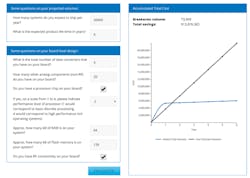What’s the Better IIoT Chip Solution: Custom or Off the Shelf?
Download this article in PDF format.
The media loves to play up some of the most outlandish inventions intended for Internet of Things (IoT) applications. While inventions such as internet-capable toothbrushes and fridges make the headlines, other developers are working under the radar to bring the IoT to life.
In fact, the consumer area is not expected to be the biggest adopter of the “connected world”—that honor falls to the industrial sector. The Industry 4.0 philosophy was developed in Germany and has had a major influence in manufacturing, but the Industrial Internet of Things (IIoT) encompasses much more, including HVAC, transportation, and smart metering.
It could be said that the IIoT covers everything that was once termed machine-to-machine (M2M) networking, and more. The IIoT offers the lure of making industry more efficient and flexible. It also promises to streamline asset management and services, as well as enable accurate predictive maintenance for those systems.
The most basic functional blocks in IIoT systems are sensors to detect and measure almost every aspect of the process and environment, data converters (from analog to digital and back), processing, memory, and communications technology to provide the control link to actuators as well as serve data to the remote servers that collate and analyze the data. The remote servers may be installed in-house, or use cloud computing in external data centers.
Normally, solutions such as these sensor-based systems are designed on printed circuit boards (PCBs) using individual components. The microcontrollers developed for on-board processing have made life easier for designers by including many of the functions outside of pure processing. A wide variety of multipoint control units (MCUs) offer peripherals that can take care of data conversion, memory functions, and wired and wireless connectivity options. These systems still need many other external components to operate effectively.
Sensing, Presenting, and Acting on Data
As processes have become more automated, the systems that provide the automation have also seen increased growth in the number of inputs and outputs. A typical industrial system is detailed in Figure 1. The inputs are provided from a number of different sources, which include switches, touchpads, sensors, and encoders. The sensors are designed to provide input from processes and the environment to give an all-around view of the operation.
1. Shown are the typical control board functional blocks.
These sensors can measure pressure, temperature, acceleration, and many other traits. The system also requires an equally varied selection of outputs, including displays, switches, motors, and actuators. Furthermore, the vast majority of automated processes need connectivity, whether wired or wireless. Either side of the processing element typically requires a degree of signal conditioning to ensure devices can communicate more easily. The signal conditioning can take a variety of forms, from simple voltage-level shifting to more complex conditioning functions.
It is easy to underestimate the complexity of designs. Even a fairly simple control board may consist of several hundred components that have to be specified, sourced, bought, and stored before the board is populated. This large array of components is necessary, because no single IC can be purchased to fulfill all of the required functions. Most off-the-shelf, standard components have generic performance, in that they have been designed to fit a wide variety of roles. This means that compromises are usually made when specifying devices.
Industrial-Strength IoT
When selecting components, there is always a chance of them becoming obsolete before the end of the product’s lifetime. One main reason why this occurs is that many standard components have been developed for consumer markets and may only have a short product lifecycle of only a few years.
The reasons mentioned above spell out why a custom IC may be the optimal solution for industrial products. These ICs do exactly what is required without making any compromises, require fewer external components, and won’t become unexpectedly obsolete.
These are not the only advantages of creating a custom chip, though. Among the many other benefits are that the custom chip solution will be both smaller and lighter than an off-the-shelf version. The custom solution will also use less power and be easier to test. The IP will be much more secure, which is a real benefit for IIoT solutions, as it takes much more effort to reverse-engineer a chip. Moreover, the custom solution allows for greater product differentiation, as other companies will find the design harder to copy efficiently using standard components.
Custom Chips
The potential savings are far more than the bill of materials (BOM) alone. Customization drastically simplifies the entire specifying, sourcing, purchasing, and storage cycle, as well as the production and testing phases. For example, one application was able to reduce the BOM from $90 to $10. And this did not even take into account the extra costs regarding sourcing, purchasing, and storage of the additional components. Having a more energy-efficient solution also results in savings over time.
Each application is different, but in some cases, overall cost savings reaching 80% have been shown to be possible over the product’s lifetime. Again, depending on the exact application, complexity, and quantity, the payback period can be as little as a year.
The perception of custom chip design is it being a very complex process that has a high initial cost, especially for small-volume runs of only tens of thousands of chips each year. If the perceived initial cost were less, it is possible that more industrial companies would look at the possibilities of a custom IC. But is there a large up-front cost?
The semiconductor innovation cycle is well understood in the industry. Transistor size shrinks regularly, and a greater number of them can therefore be etched on a chip. The cost of these advanced processes is high, as each new generation adds more complexity to the process. Mask sets for chip manufacture can run into the millions of dollars. However, industrial designers do not require devices with this type of complexity.
Mixed-signal designs that use both analog and digital technology are built on older processes. Achieving the level of performance for typical industrial applications usually requires a much less sophisticated process. In a majority of industrial applications, the latest process technology would not be able to handle the higher voltages found in industrial control. The processes used to manufacture chips for these applications are mature and well understood. These chips are also normally fabricated on equipment that is fully depreciated, so costs are well below those found in bleeding-edge processes.
How much a custom chip will cost depends on its functionality and level of integration. The first step is to do an analysis by comparing the cost of the non-integrated solution composed of a board with discrete components to a fully integrated chip solution. The total cost of the chip must be calculated over the entire lifetime of the product. Below are eight key factors one should consider when determining the cost of an integrated mixed-signal chip design.
- How many systems incorporating the custom chip will be required annually?
- What is the expected lifetime of the product, including all variants?
- How many discrete data converters will be needed in addition to those on the microcontroller?
- How many other analog components will be required?
- Will the design need a microcontroller?
- What performance will be required from the microcontroller? You can scale this from a basic 8-bit processor (1) to an ARM 64-bit multicore (4).
- How much RAM is required? How much flash memory? Will the memory be on-board, on the custom chip, or mixed?
- Will the board require RF connectivity? Initially, the type of protocol is not important.
2. S3 Semiconductors’ online calculator makes it easy to see if shrinking a board onto a custom IC is an economical option for your application.
The answers to these questions should give a rough estimate of the costs and enable you to calculate the break-even point of the custom design. You can use the free online calculator developed by S3 Semiconductors to help with the calculation (Fig. 2). The calculator will show the estimated break-even volume and timeline, as well as the total lifetime savings in U.S. dollars.
About the Author
Darren Hobbs
Director of Marketing & Strategy
Darren Hobbs has over 20 years of experience operating in the semiconductor industry in roles such as CMO, Product Line Management, Product Marketing, and Project Management in a mix of SME and large multinationals. He holds an executive MBA from Henley Management College (UK) and a degree in Electrical Engineering from University College Cork (Ireland).



